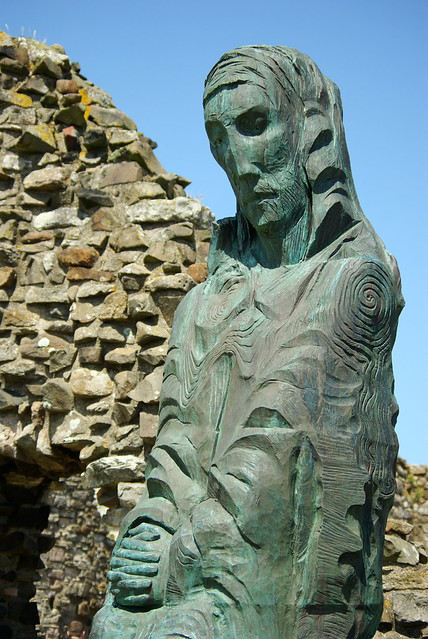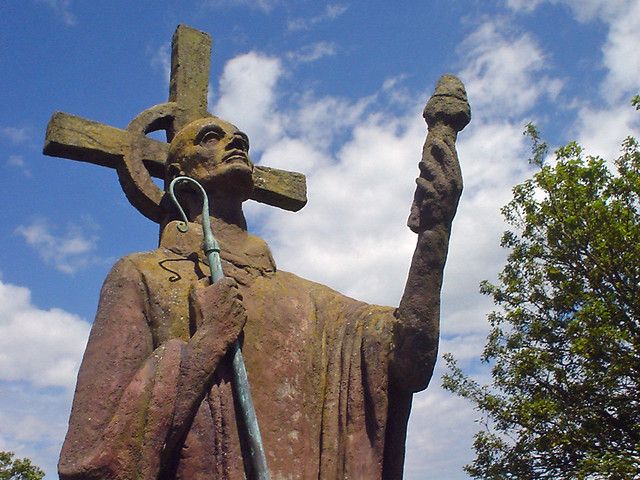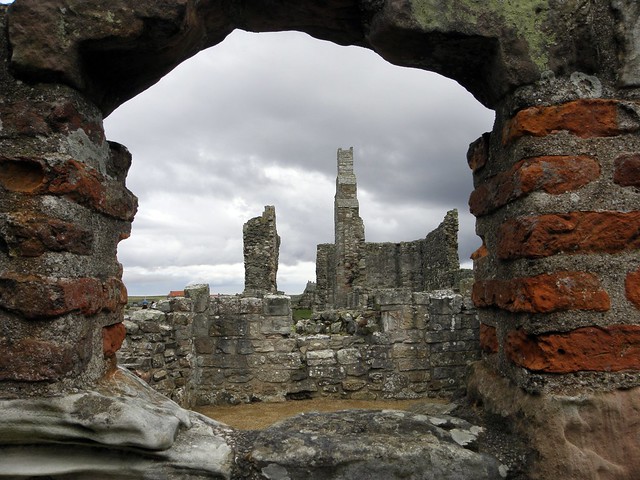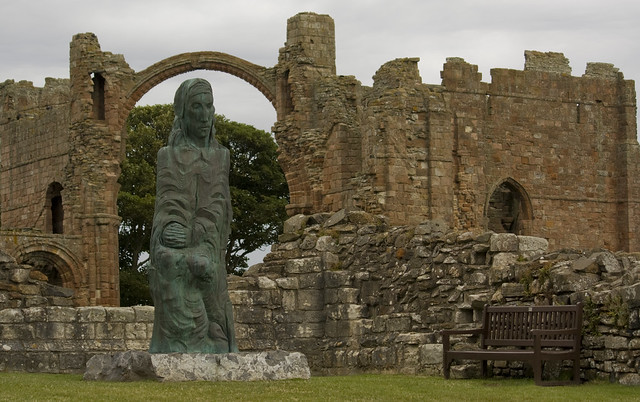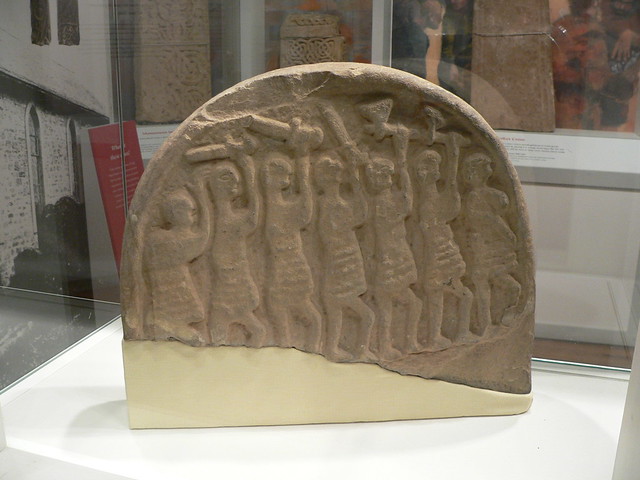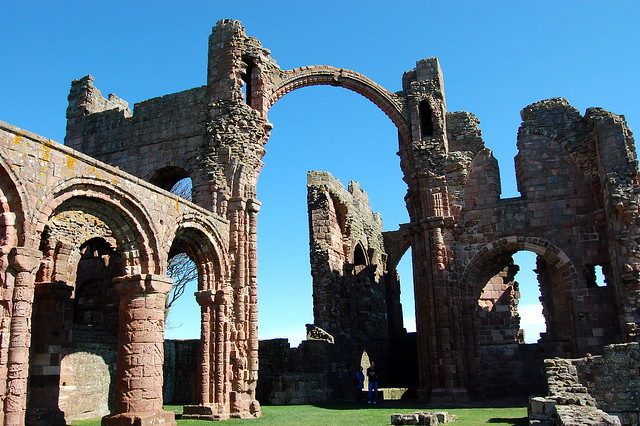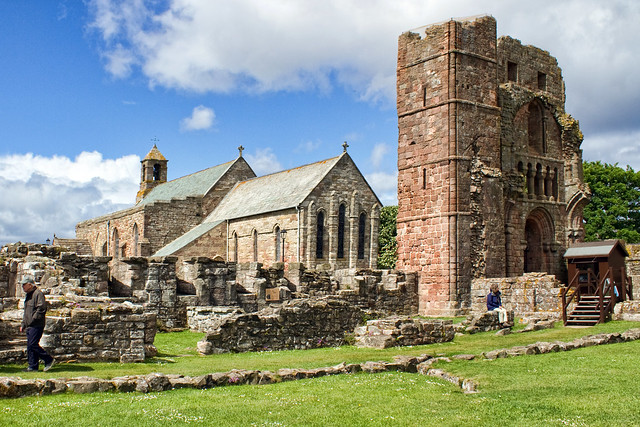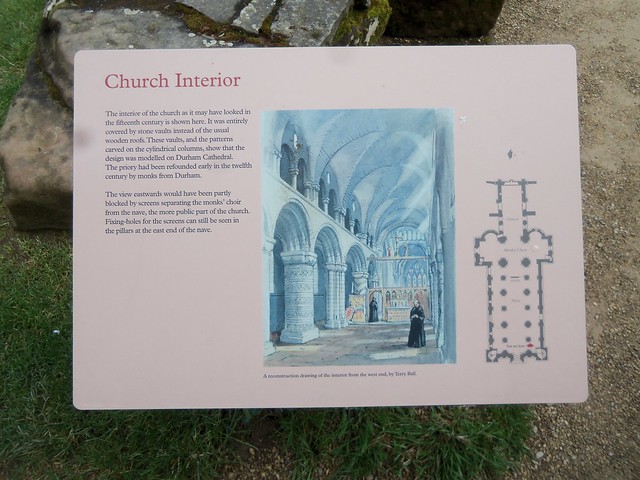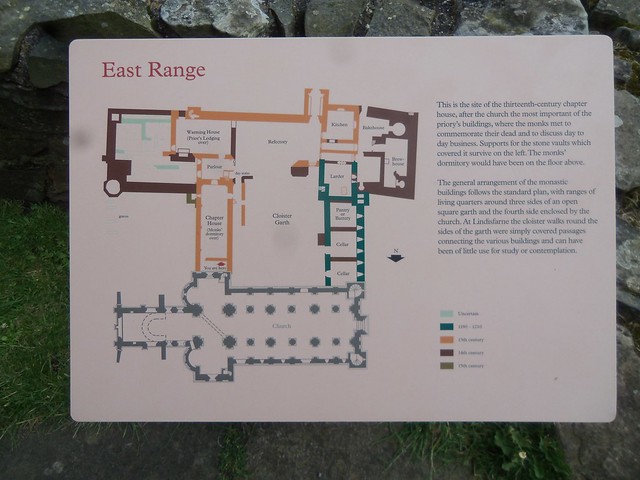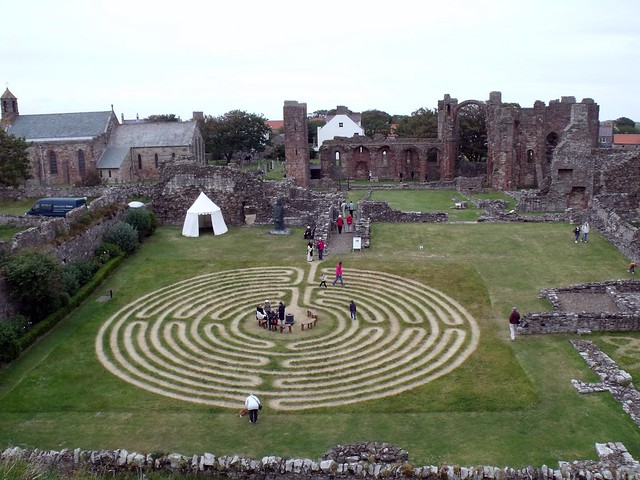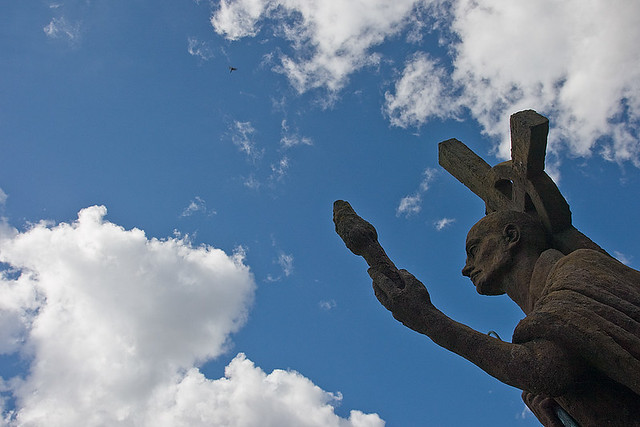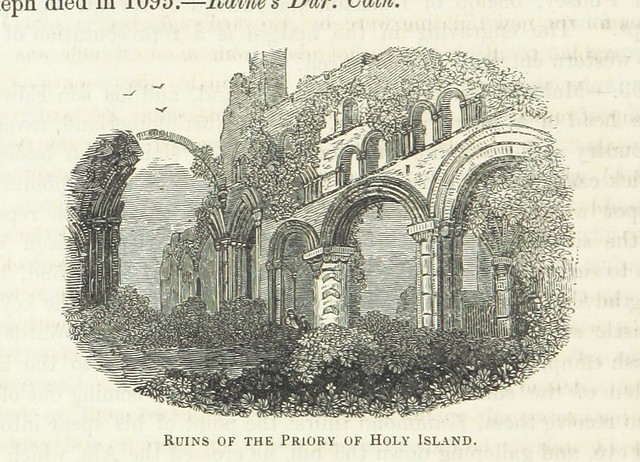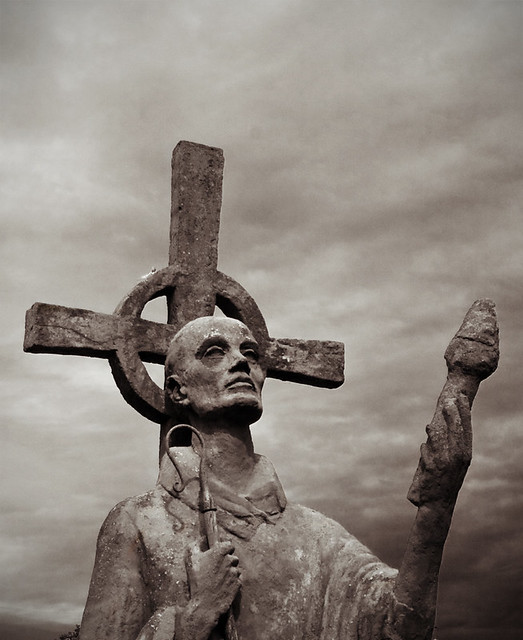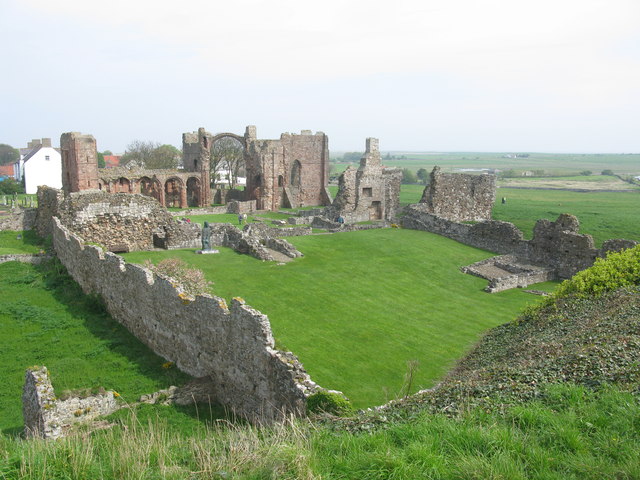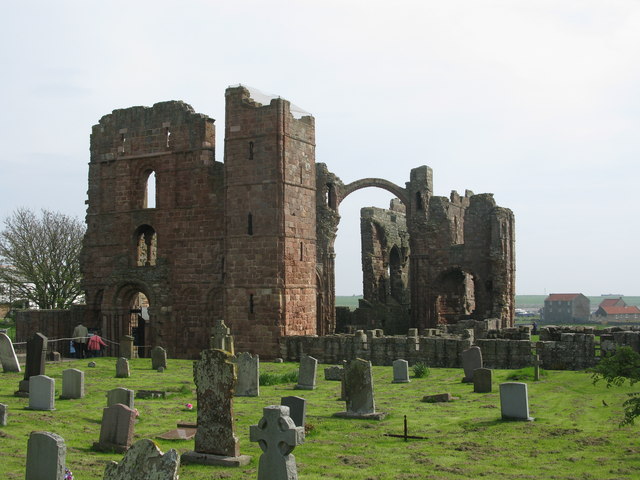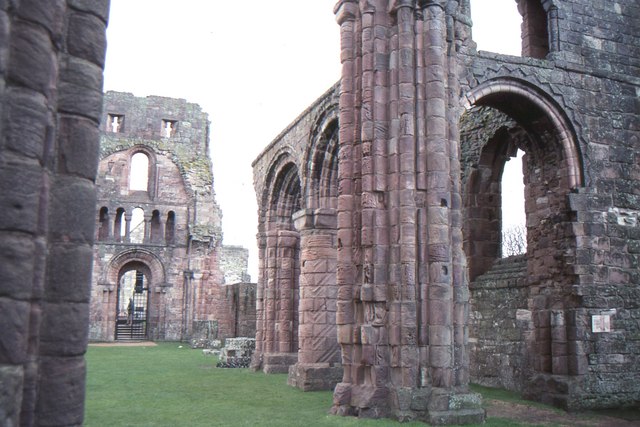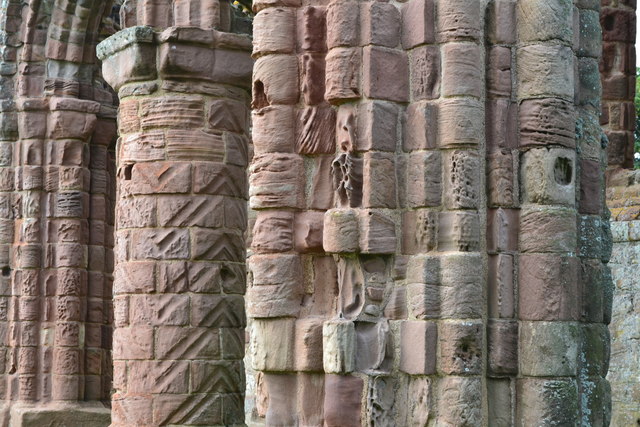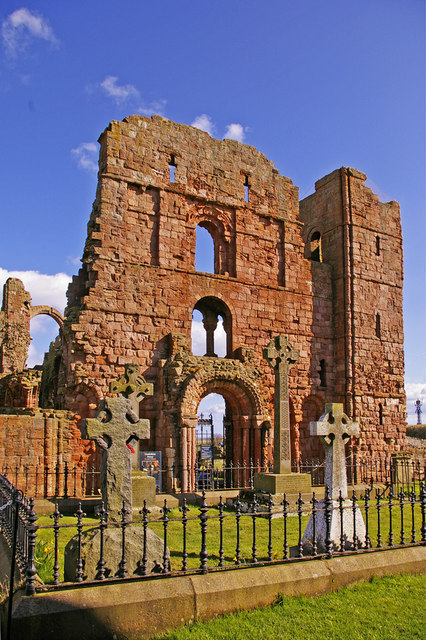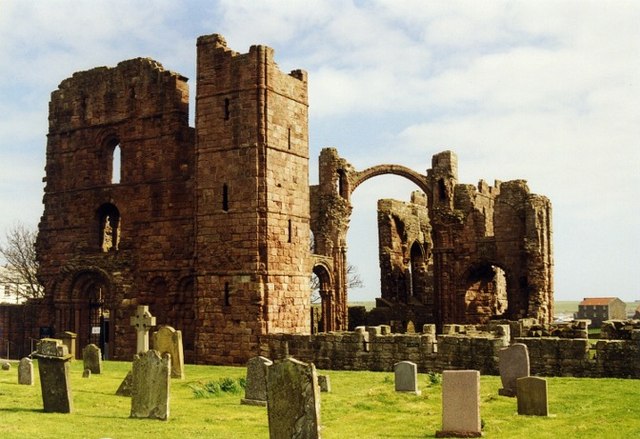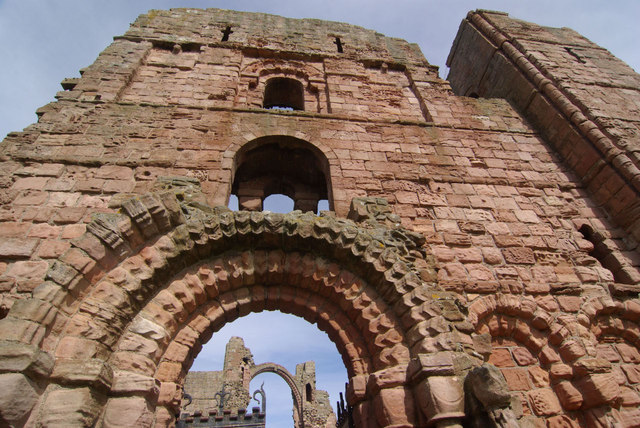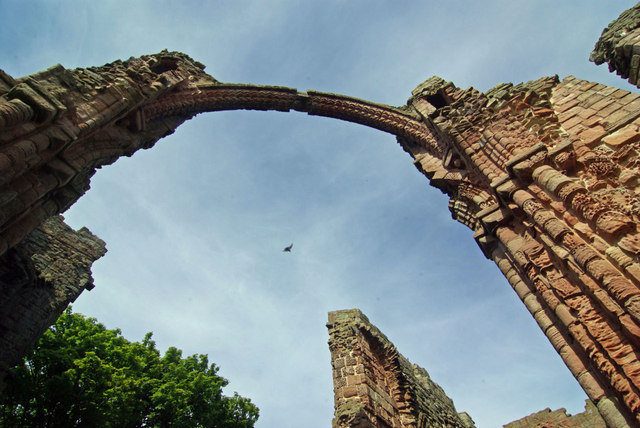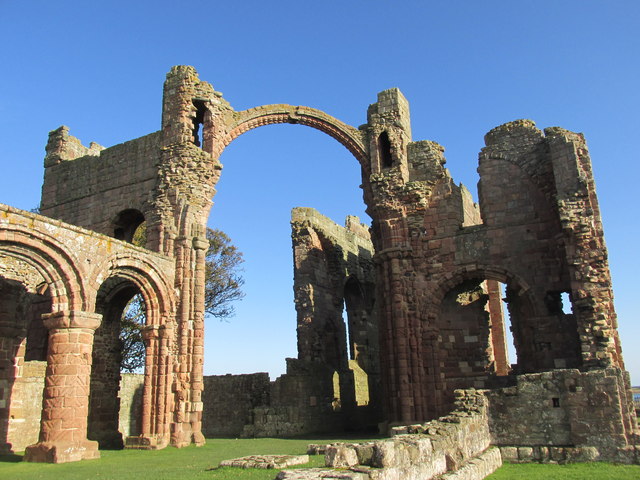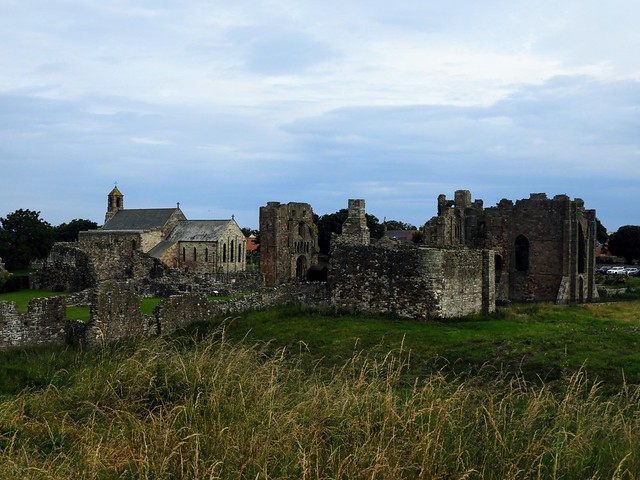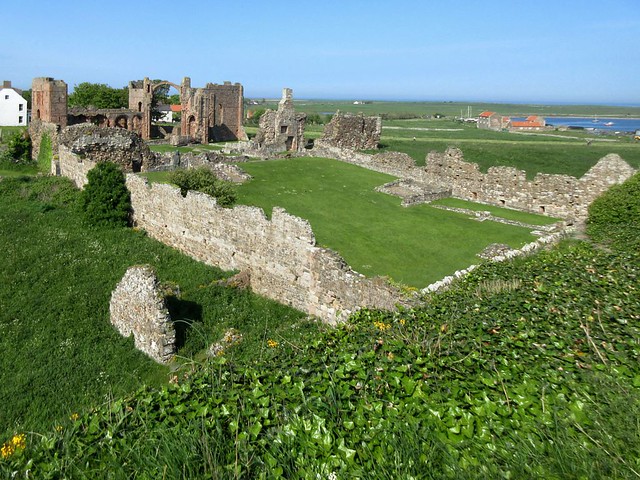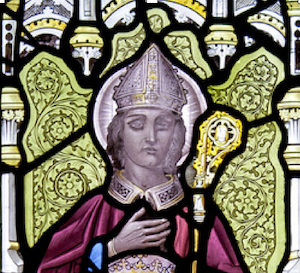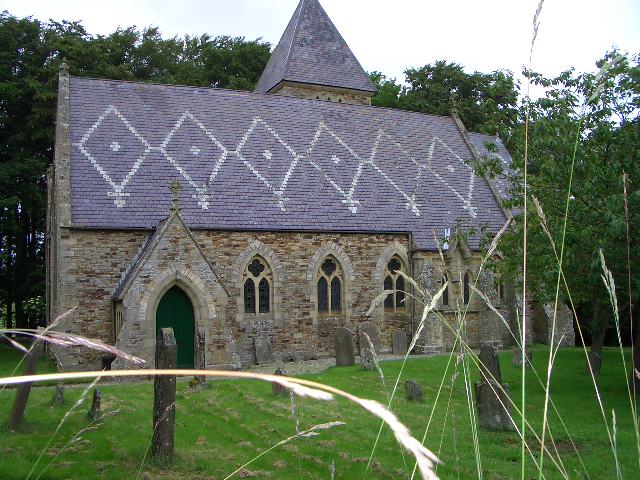Topics > Northumberland > Holy Island > Lindisfarne Priory
Lindisfarne Priory
"Lindisfarne was the site of the earliest Christian monastery in Anglo-Saxon Northumbria and one of the most important centres of early Christianity in England. Irish monks settled here in AD 635 at the invitation of the Northumbrian king [Oswald], and the monastery became the centre of a major saint’s cult celebrating its bishop, Cuthbert. It was here that the masterpiece now known as the Lindisfarne Gospels was created in the early 8th century. The ruins now visible are those of a small priory established in the 12th century by monks from Durham, which claimed direct descent from the early monastery." (English Heritage) The remains of Lindisfarne Priory are Grade I listed on the National Heritage List for England.
The monastery of Lindisfarne was founded by Irish monk Saint Aidan, who had been sent from Iona off the west coast of Scotland to Northumbria at the request of King Oswald. The priory was founded before the end of 634 and Aidan remained there until his death in 651. The priory remained the only seat of a bishopric in Northumbria for nearly thirty years. Finian (bishop 651–661) built a timber church "suitable for a bishop's seat". St Bede, however, was critical of the fact that the church was not built of stone but only of hewn oak thatched with reeds. A later bishop, Eadbert removed the thatch and covered both walls and roof in lead. An abbot, who could be the bishop, was elected by the brethren and led the community. Bede comments on this:
Lindisfarne became the base for Christian evangelism in the North of England and also sent a successful mission to Mercia. Monks from the Irish community of Iona settled on the island. Northumbria's patron saint, Saint Cuthbert, was a monk and later abbot of the monastery, and his miracles and life are recorded by the Venerable Bede. Cuthbert later became Bishop of Lindisfarne. An anonymous life of Cuthbert written at Lindisfarne is the oldest extant piece of English historical writing. From its reference to "Aldfrith, who now reigns peacefully" it must date to between 685 and 704. Cuthbert was buried here, his remains later translated to Durham Cathedral (along with the relics of Saint Eadfrith of Lindisfarne). Eadberht of Lindisfarne, the next bishop (and saint) was buried in the place from which Cuthbert's body was exhumed earlier the same year when the priory was abandoned in the late 9th century.
Cuthbert's body was carried with the monks, eventually settling in Chester-le-Street before a final move to Durham. The saint's shrine was the major pilgrimage centre for much of the region until its despoliation by Henry VIII's commissioners in 1539 or 1540. The grave was preserved, however, and when opened in 1827 yielded a number of remarkable artefacts dating back to Lindisfarne. The inner (of three) coffins was of incised wood, the only decorated wood to survive from the period. It shows Jesus surrounded by the Four Evangelists. Within the coffin was a pectoral cross across made of gold and mounted with garnets and intricate tracery. There was a comb made of elephant ivory, a rare and expensive item in Northern England. Also inside was an embossed silver covered travelling altar. All were contemporary with the original burial on the island. When the body was placed in the shrine in 1104 other items were removed: a paten, scissors and a chalice of gold and onyx. Most remarkable of all was a gospel (known as the St Cuthbert Gospel or Stonyhurst Gospel from its association with the college). The manuscript is in an early, probably original, binding beautifully decorated with deeply embossed leather.
Following Finian's death, Colman became Bishop of Lindisfarne. Up to this point the Northumbrian (and latterly Mercian) churches had looked to Lindisfarne as the mother church. There were significant liturgical and theological differences with the fledgling Roman party based at Canterbury. According to Stenton: "There is no trace of any intercourse between these bishops Mercians and the see of Canterbury". The Synod of Whitby in 663 changed this. Allegiance switched southwards to Canterbury and thence to Rome. Colman departed his see for Iona and Lindisfarne ceased to be of such major importance.
In 735 the northern ecclesiastical province of England was established with the archbishopric at York. There were only three bishops under York: Hexham, Lindisfarne and Whithorn whereas Canterbury had the twelve envisaged by St Augustine. The Diocese of York encompassed roughly the counties of Yorkshire and Lancashire. Hexham covered County Durham and the southern part of Northumberland up to the River Coquet and eastwards into the Pennines. Whithorn covered most of Dumfries and Galloway region west of Dumfries itself. The remainder, Cumbria, northern Northumbria, Lothian and much of the Kingdom of Strathclyde formed the diocese of Lindisfarne.
In 737 Saint Ceolwulf of Northumbria abdicated as King of Northumbria and entered the Prior at Lindisfarne. He died in 764 and was buried alongside Cuthbert. In 830 his body was moved to Norham-upon-Tweed and later his head was translated to Durham Cathedral.
Lindisfarne Gospels
At some point in the early 8th century, the famous illuminated manuscript known as the Lindisfarne Gospels, an illustrated Latin copy of the Gospels of Matthew, Mark, Luke and John, was made probably at Lindisfarne and the artist was possibly Eadfrith, who later became Bishop of Lindisfarne. Sometime in the second half of the 10th century a monk named Aldred added an Anglo-Saxon (Old English) gloss to the Latin text, producing the earliest surviving Old English copies of the Gospels. Aldred attributed the original to Eadfrith (bishop 698–721). The Gospels were written with a good hand, but it is the illustrations done in an insular style containing a fusion of Celtic, Germanic and Roman elements that are truly outstanding. According to Aldred, Eadfrith's successor Æthelwald was responsible for pressing and binding it and then it was covered with a fine metal case made by a hermit called Billfrith. The Lindisfarne Gospels now reside in the British Library in London, somewhat to the annoyance of some Northumbrians. In 1971 professor Suzanne Kaufman of Rockford, Illinois presented a facsimile copy of the Gospels to the clergy of the island.
Vikings
In 793, a Viking raid on Lindisfarne caused much consternation throughout the Christian west and is now often taken as the beginning of the Viking Age. The D and E versions of the Anglo-Saxon Chronicle record:
Her wæron reðe forebecna cumene ofer Norðhymbra land, ⁊ þæt folc earmlic bregdon, þæt wæron ormete þodenas ⁊ ligrescas, ⁊ fyrenne dracan wæron gesewene on þam lifte fleogende. Þam tacnum sona fyligde mycel hunger, ⁊ litel æfter þam, þæs ilcan geares on .vi. Idus Ianuarii, earmlice hæþenra manna hergunc adilegode Godes cyrican in Lindisfarnaee þurh hreaflac ⁊ mansliht.
In this year fierce, foreboding omens came over the land of the Northumbrians, and the wretched people shook; there were excessive whirlwinds, lightning, and fiery dragons were seen flying in the sky. These signs were followed by great famine, and a little after those, that same year on 6th ides of January, the ravaging of wretched heathen men destroyed God's church at Lindisfarne.
The generally accepted date for the Viking raid on Lindisfarne is in fact 8 June; Michael Swanton writes: "vi id Ianr, presumably [is] an error for vi id Iun (8 June) which is the date given by the Annals of Lindisfarne (p. 505), when better sailing weather would favour coastal raids."
Alcuin, a Northumbrian scholar in Charlemagne's court at the time, wrote:
Never before has such terror appeared in Britain as we have now suffered from a pagan race ... The heathens poured out the blood of saints around the altar, and trampled on the bodies of saints in the temple of God, like dung in the streets.
The English seemed to have turned their back on the sea as they became more settled. Many monasteries were established on islands, peninsulas, river mouths and cliffs. Isolated communities were less susceptible to interference and the politics of the heartland. The amazement of the English at the raids from the sea must have been matched by the amazement of the raiders at such (to them) vulnerable, wealthy and unarmed settlements.
These preliminary raids, unsettling as they were, were not followed up. The main body of the raiders passed north around Scotland. The 9th-century invasions came not from Norway, but from the Danes from around the entrance to the Baltic. The first Danish raids into England were in the Isle of Sheppey, Kent during 835 and from there their influence spread north. During this period religious art continued to flourish on Lindisfarne, and the Liber Vitae of Durham began in the priory.
By 866 the Danes were in York and in 873 the army was moving into Northumberland. With the collapse of the Northumbrian kingdom the monks of Lindisfarne fled the island in 875 taking with them St Cuthbert's bones (which are now buried at the cathedral in Durham).
Prior to the 9th century Lindisfarne Priory had, in common with other such establishments, held large tracts of land which were managed directly or leased to farmers with a life interest only. Following the Danish occupation land was increasingly owned by individuals and could be bought, sold and inherited. Following the Battle of Corbridge in 914 Ragnald seized the land giving some to his followers Scula and Onlafbal.
Middle Ages
The priory was re-established in Norman times in 1093 as a Benedictine house and continued until its suppression in 1536 under Henry VIII. The standing remains date from this later priory, while the site of the original priory is now occupied by the parish church. The site is a grade I listed building number 1042304. The earliest parts of the area are a scheduled ancient monument number 1011650.
In 1462, during the Wars of the Roses, Margaret of Anjou made an abortive attempt to seize the Northumbrian castles. Following a storm at sea 400 troops had to seek shelter on Holy Island, where they surrendered to the Yorkists.
An early scholarly description of the priory was compiled by Dr Henry George Charles Clarke (presumed son of Admiral Sir Erasmus Gower) in 1838 during his term as president of the Berwickshire Naturalists' Club. . Dr Clarke surmised that this Norman priory was unique in that the centre aisle had a vault of stone. Of the six arches, Dr Clarke stated "as if the architect had not previously calculated the space to be occupied by his arcade. The effect here has been to produce a horse-shoe instead of a semicircular arch, from its being of the same height, but lesser span, than the others. This arch is very rare, even in Norman buildings".
Visit the page: Lindisfarne for references and further details. You can contribute to this article on Wikipedia.

Co-Curate Page
Lindisfarne Gospels
- The Lindisfarne Gospels is a ceremonial illustrated manuscript incorporating the gospels of Saints Matthew, Mark, Luke and John, and art work with Anglo-Saxon and Celtic influences. The manuscripts were produced …

from http://www.english-heritage.o…
Lindisfarne Priory - English Heritage
- "The extensive ruins visible today are dominated by the 12th-century priory church, which probably stands on the same spot as its Anglo-Saxon predecessor. The associated monastic buildings were modified in …
Added by
Simon Cotterill
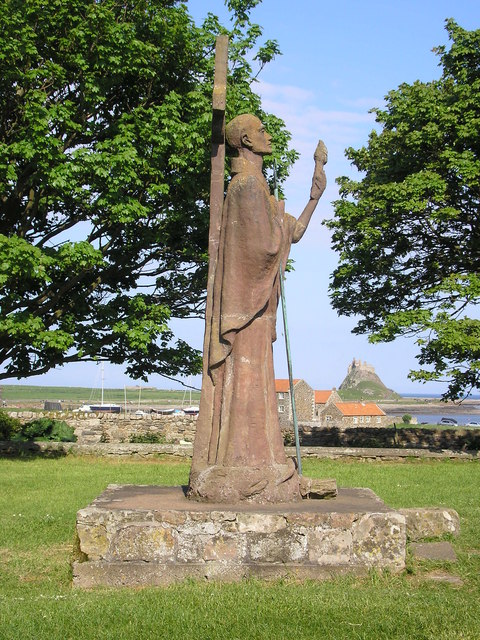
Co-Curate Page
St Aidan of Lindisfarne (c.590 - 651)
- Overview About Aidan of Lindisfarne Aidan was born in Ireland c.590 AD and becoming a monk on the Scottish island of Iona. He came to Lindisfarne at the request of …

from Youtube (youtube)
aerial video with drone - holy island with priory - 03.03.2016
Pinned by Simon Cotterill
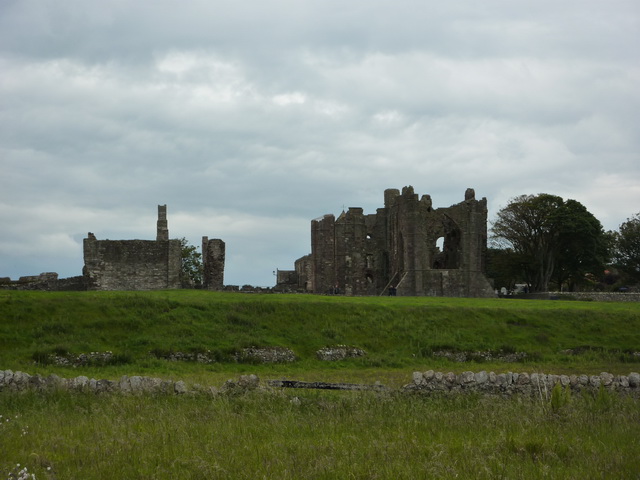
from Geograph (geograph)
Lindisfarne Priory as viewed from The Ouse, Holy Island
Pinned by Simon Cotterill

from https://holy-island.uk/lindis…
Lindisfarne Priory: visitor information, history, saints
- Visitor information, opening times, costs, history, saints and Vikings. Includes a story-based write-up of the Priory's history and Saints Aidan and Cuthbert.
Added by
Danny Dagan

from Youtube (youtube)
Postcard from Lindisfarne Priory, Northumberland | Drone Footage
Pinned by Simon Cotterill

from Youtube (youtube)
Lindisfarne Priory | 10 Places That Made England with Dan Snow
Pinned by Simon Cotterill


Co-Curate Page
Lindisfarne Gospels
- The Lindisfarne Gospels is a ceremonial illustrated manuscript incorporating the gospels of Saints Matthew, Mark, Luke and John, and art work with Anglo-Saxon and Celtic influences. The manuscripts were produced …

from http://www.english-heritage.o…
Lindisfarne Priory - English Heritage
- "The extensive ruins visible today are dominated by the 12th-century priory church, which probably stands on the same spot as its Anglo-Saxon predecessor. The associated monastic buildings were modified in …
Added by
Simon Cotterill

Co-Curate Page
St Aidan of Lindisfarne (c.590 - 651)
- Overview About Aidan of Lindisfarne Aidan was born in Ireland c.590 AD and becoming a monk on the Scottish island of Iona. He came to Lindisfarne at the request of …

from Youtube (youtube)
aerial video with drone - holy island with priory - 03.03.2016
Pinned by Simon Cotterill

from Geograph (geograph)
Lindisfarne Priory as viewed from The Ouse, Holy Island
Pinned by Simon Cotterill

from https://holy-island.uk/lindis…
Lindisfarne Priory: visitor information, history, saints
- Visitor information, opening times, costs, history, saints and Vikings. Includes a story-based write-up of the Priory's history and Saints Aidan and Cuthbert.
Added by
Danny Dagan

from Youtube (youtube)
Postcard from Lindisfarne Priory, Northumberland | Drone Footage
Pinned by Simon Cotterill

from Youtube (youtube)
Lindisfarne Priory | 10 Places That Made England with Dan Snow
Pinned by Simon Cotterill
List number: 1042304
County: Northumberland
Grid ref: NU1263141764
Post code: TD15 2RX

